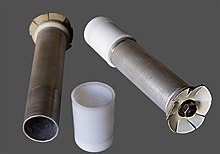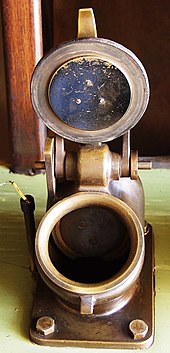Prague pneumatic post: Difference between revisions
Lilac Soul (talk | contribs) Removing link to empty page Jindřišská st. using popups |
Jiri Svoboda (talk | contribs) Add map image |
||
| Line 1: | Line 1: | ||
[[Image:Rohrpost_prag_linienplan.jpg|thumb|Map of the Prague pneumatic post]] |
|||
[[Image:hlavní-panel.jpg|thumb|Main control panel, showing the inlets, outlets and lane controllers]] |
[[Image:hlavní-panel.jpg|thumb|Main control panel, showing the inlets, outlets and lane controllers]] |
||
The '''Prague pneumatic post''' (Czech: Pražská potrubní pošta) is an underground system of metal tubes measuring 60 kms.<ref name="service">Lazarová, Daniela. (November 10, 2003) [[Radio Prague]] ''[http://www.radio.cz/en/article/46193 The international service of Czech Radio.]'' Accessed June 16, 2008</ref> The tubes travel from one end of Prague to the other and are used to transport mail.<ref name="service"/> Known as the Old Lady of Czech telecommunications, the system was rendered inoperative by [[2002 European floods|floods in 2002]].<ref name="service"/> The pneumatic system is the world's last preserved [[Township|municipal]] [[Pneumatic tube|pneumatic post]] mail system.<ref>Wertheim, Margaret. (October 23, 1999) [[New Scientist]] ''[http://www.newscientist.com/article/mg16422095.000-bones-to-phones.html Bones to phones.]'' Volume 164; Issue 2209; Section: Features; Page 40.</ref> The system has been used by the President's Office, the government, banks and the media for over a hundred years.<ref name="service"/> The current owner, [[Telefónica O2 Czech Republic]] gradually is repairing and conserving the system.<ref name="service"/> Due to limited funding the system is still inoperative.<ref name="service"/> |
The '''Prague pneumatic post''' (Czech: Pražská potrubní pošta) is an underground system of metal tubes measuring 60 kms.<ref name="service">Lazarová, Daniela. (November 10, 2003) [[Radio Prague]] ''[http://www.radio.cz/en/article/46193 The international service of Czech Radio.]'' Accessed June 16, 2008</ref> The tubes travel from one end of Prague to the other and are used to transport mail.<ref name="service"/> Known as the Old Lady of Czech telecommunications, the system was rendered inoperative by [[2002 European floods|floods in 2002]].<ref name="service"/> The pneumatic system is the world's last preserved [[Township|municipal]] [[Pneumatic tube|pneumatic post]] mail system.<ref>Wertheim, Margaret. (October 23, 1999) [[New Scientist]] ''[http://www.newscientist.com/article/mg16422095.000-bones-to-phones.html Bones to phones.]'' Volume 164; Issue 2209; Section: Features; Page 40.</ref> The system has been used by the President's Office, the government, banks and the media for over a hundred years.<ref name="service"/> The current owner, [[Telefónica O2 Czech Republic]] gradually is repairing and conserving the system.<ref name="service"/> Due to limited funding the system is still inoperative.<ref name="service"/> |
||
Revision as of 12:21, 17 June 2008

The Prague pneumatic post (Czech: Pražská potrubní pošta) is an underground system of metal tubes measuring 60 kms.[1] The tubes travel from one end of Prague to the other and are used to transport mail.[1] Known as the Old Lady of Czech telecommunications, the system was rendered inoperative by floods in 2002.[1] The pneumatic system is the world's last preserved municipal pneumatic post mail system.[2] The system has been used by the President's Office, the government, banks and the media for over a hundred years.[1] The current owner, Telefónica O2 Czech Republic gradually is repairing and conserving the system.[1] Due to limited funding the system is still inoperative.[1]
History
The Prague pneumatic post entered public service on March 4, 1899.[1] The first lane had been constructed as early as 1887, but at first it only served internal purposes. It ran from the main post office in Jindřišská st. to the post bureau at Malé náměstí square in the Old Town. (This bureau was situated in a corner house with Linhartská st., belonging to the V. J. Rott company, next to a house that is called 'U Rotta' today.) The first lane was later extended as far as the Prague Castle, making it over 5 km long. Prague was the fifth city in the world to receive a pneumatic post system -after London, Vienna, Berlin, and Paris, which was considered a major achievement for Prague.[1]
The system initially was employed mainly for sending telegrams. The United Kingdom House of Commons noted that only three stations had been connected between the Prague post and the telegraph office as of 1901.[3]
The system was set up for those desiring to send a document fast.[1] The document would be taken to the post office and rolled up into a metal capsule.[1] The clerk would then drop the metal capsule down a hatch leading to a predestined location.[1] After the clerk pressed a button, the capsule would be moved on a wave of compressed air down a network of tubes buried under the pavement.[1]
The main growth of the network dates to the economically prosperous era of 1927–1932. In those years, new lanes were constructed and tens of thousands of capsules were transported per month. During World War II the pneumatic post played a significant role in supplying the besieged building of the Czech radio.
In the 1990s, the system transported about 10,000 documents a day.[1] The traffic weakened gradually and the 2002 floods have put a stop to it, for the time being.[1]
Pipes

The lanes consist of steel pipes of 65 mm bore and wall thickness of 2.5–3 mm. The pipes are connected with tight couplers 14 cm long to ensure perfect coaxial alignment and then welded together, ensuring air-tightness. To prevent dispersion current from causing excess corrosion, ceramic insulators are inserted between the pipe segments at some places. Pipes buried underground are protected from the outside by a layer of fiberglass, wound around at increased temperature and coated with hot asphalt. The pipeline is typically buried under the Prague sidewalks 80–120 cm deep. Inside buildings and in the Prague trunk conduit network the pipes simply are coated with anti-corrosive paint. The minimum bend radius is 250 cm for underground pipes, but 300 cm is the most commonly used radius. Inside buildings a bend radius as low as 200 cm is allowed. The bends are made of special annealed pipes at normal temperature, using a custom-made bender.
A signaling cable is laid along with the pipe, enabling communication with the track components.
The lane segments are equipped with dumb wells, where the pipeline can be open and inspected, or where a stuck capsule can be removed. For this purpose a heavier capsule can be sent at a pressure of up to 30 atm, knocking the stuck capsule out.
Transport capsule

Aluminum capsules travel along the pipes, measuring 48 mm in outer-diameter and 200 mm in length. On the rear end they are fitted with a plastic circlet, preventing friction against walls of the pipe and a soft plastic skirt, sealing air behind the capsule. The diameter of the rear circlet is 57 mm. The remaining 8 millimeters of the bore are sealed just by the skirt, allowing for excellent airtightness and low friction at the same time.
Propulsion units

Invalid arguments have been passed to the {{#coordinates:}} function
Each lane is equipped with a dedicated propulsion unit, consisting of an electrically-powered air pump. One pump can service at most 3 kilometers of pipeline, so it's necessary to use several pumps on lanes longer than 3 km.
The pumps must be reversable, creating either pressure or vacuum. The pumps are connected to the pipes with tee-fittings. On both sides of the tee the pipe is equipped with switches activated by a passing capsule.

At first the pump is set to intake mode, pulling the capsule towards the tee. Before reaching it, the capsule hits the first switch, causing the pump to start reversing. Meanwhile the capsule reaches the tee-fitting. As it passes the tee, the pump is already fully reversed and starts to push the capsule away.
The older pumps were bladed, having a single blade, mounted eccentrically inside a 300 mm high cylinder. More recent pumps employ a rotating piston instead.
Packages
The capsules can be loaded with packages up to 5 cm in diameter and 30 cm in length. Their weight can be up to 3 kg. Generally these were rolled-up telegrams, but any package within the set limits could be transported.
For obvious reasons, dangerous and corrosive substances, which could damage the pipeline, were banned. On the other hand, the travel speed could be adjusted, allowing for transporting fragile packages.
Lanes and stations

The Prague pneumatic post network consists of five main lanes arranged in a star topology, fitted with switches and concentrators, and of subscriber's lines. The total length of the lanes is about 55 kilometers. Some of the most frequented segments have two pipes (one for each direction), but the majority of the lanes use a single pipe and the direction is determined by setting up the pumps to run in the desired direction. The main lanes connect the following post offices and bureaus:
- Jindřišská st.–Prague 2, Prague 3, Prague 10
- Jindřišská st.–Prague 1, Prague 2
- Jindřišská st.–Prague 5
- Jindřišská st.–Prague 6
- Jindřišská st.–Prague 7
Originally there were 16 subscriber's lines, but only 7 have been preserved up till today. A total of 24 pneumatic post stations remain today.
The network crosses the river Vltava in three spots making use of bridges (Hlávkův most, Mánesův most, most Legií).
The headquarters/switchboard

All the lanes converge to the main post office in Jindřišská st. Here all the packages were carefully recorded and from here the network was controlled and monitored. This is also the place where the packages were forwarded from one lane to another. The capsule was picked up from a receiving pocket by a member of the staff, recorded and inserted into the inlet of another lane.
The current lane state was indicated by indicator lights on the lane's controller. Up to 10 packages in 30-second intervals could be sent on the same lane at once, although this was rarely used in practice.
When sending capsules to switched lanes, the capsules had to be sent out in a predefined order, as the switches could only be activated before commencing the transfer. The first capsule would be diverted, after which the switch would automatically slide back to its neutral position, sending the remaining capsules in the straight direction. Therefore, the capsule that was meant to branch off had to be sent first.
References
- ^ a b c d e f g h i j k l m n Lazarová, Daniela. (November 10, 2003) Radio Prague The international service of Czech Radio. Accessed June 16, 2008
- ^ Wertheim, Margaret. (October 23, 1999) New Scientist Bones to phones. Volume 164; Issue 2209; Section: Features; Page 40.
- ^ Forbes, Wentworth. (1901) House of Commons Sessional Papers. (1902) Report on the trade of the Kingdom of Bohemia for 1901
